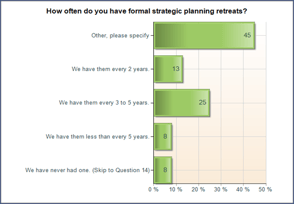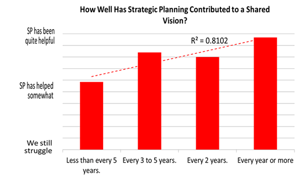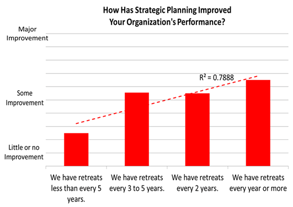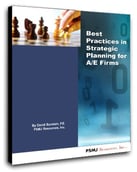In a recent PSMJ report, Best Practices in Strategic Planning for A/E Firms, we present the results of a survey that we did with 75 architecure and engineering firms on how they conduct strategic planning. Our goal is to provide new insight into how your firm can maximize your strategic planning efforts for success in 2016.
We begin the study with questions on demographics and results of the survey on how A/E firms conduct strategic planning. And then, we did some mining of this data to figure out what works and what doesn’t work in strategic planning. We first compared various strategic planning practices with how well these practices contributed to a shared vision among the firm’s leaders. We then compared the reported strategic planning practices with the degree of improvement in their firm’s performance. The results are very interesting and sometimes counterintuitive.

Firms vary greatly in terms of how frequently they have strategic planning retreats.
One of the first things we asked firms was how often they do strategic planning retreats. We found that the most common response was every 3-5 years (25%). Other (45%) is a whole hodgepodge of time frames—the biggest category being every year (or more). Only 8% of firms said they have never done a strategic planning retreat.
 Firms That Plan Every Year (or More) Have a More Aligned Strategic Vision
Firms That Plan Every Year (or More) Have a More Aligned Strategic Vision
We then looked at how the frequency of strategic planning retreats contributes to a shared vision.
We broke the 75 participants into groups based on how often they held a strategic planning retreat. We found that firms that conduct strategic planning every year or more achieve the highest rating in terms of how well strategic planning contributes to a shared vision among firm leaders. So if you want a strategic plan that really gets your senior leaders aligned, have a retreat every year or more.
 …And They Achieve Better Performance
…And They Achieve Better Performance
We then looked at how the frequency of strategic planning retreats improves performance.
We looked at that same grouping, and asked how has the frequency of strategic planning improved participating firms’ performance. Again we found that the highest level of performance improvement is achieved by firms that have retreats every year or more. Meanwhile, firms that have strategic planning retreats less than every five years achieve the lowest level of performance improvement, in fact significantly lower.
But It’s Not Over When It’s Over!
Finally, to help you conduct better strategic planning at your firm, we talk specifically about some things that we have learned over the many years we have been engaged in strategic planning with architecture and engineering firms. We wrap up with some recommendations on best practices in strategic planning including the need for follow up and accountability after you completed your strategic planning retreat.
In other words, don’t leave the retreat without setting up a series of scheduled meetings to review the status of each person’s action items. These should generally be held every 2 to 4 months, depending on the amount of activity scheduled for that period. To be sure everyone attends, have each retreat participant put the scheduled update meetings onto their calendars before leaving the retreat.
And be sure to establish agreed upon consequences for those who miss their deadlines. For example, one firm elected to impose a “late fee” of $100 for anyone who misses a deadline. All the late fees were then donated to the firm’s charity.
Now it's your turn: How does your firm maximize its strategic planning efforts?
About the Author: David Burstein P.E. is Director of Client Services for PSMJ Resources, Inc. As part of his responsibilities, he provides consulting and training services on the subjects of strategic planning, marketing, project management, human resources, quality, finance and ownership transition. He is a lead instructor for PSMJ's AEC Project Management Bootcamp.

PSMJ's Best Practices in Strategic Planning for A/E Firms is available as a complimentary download.


